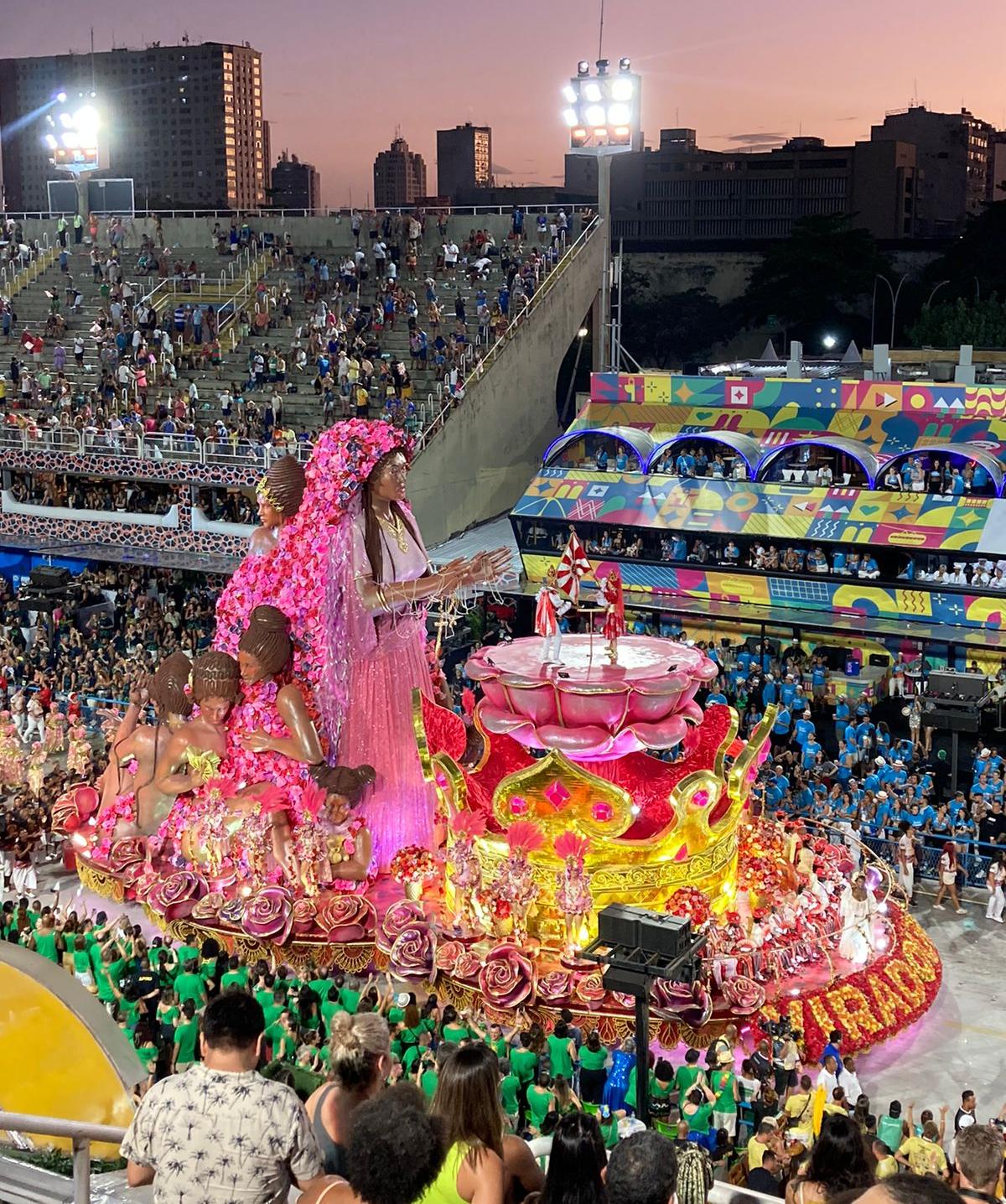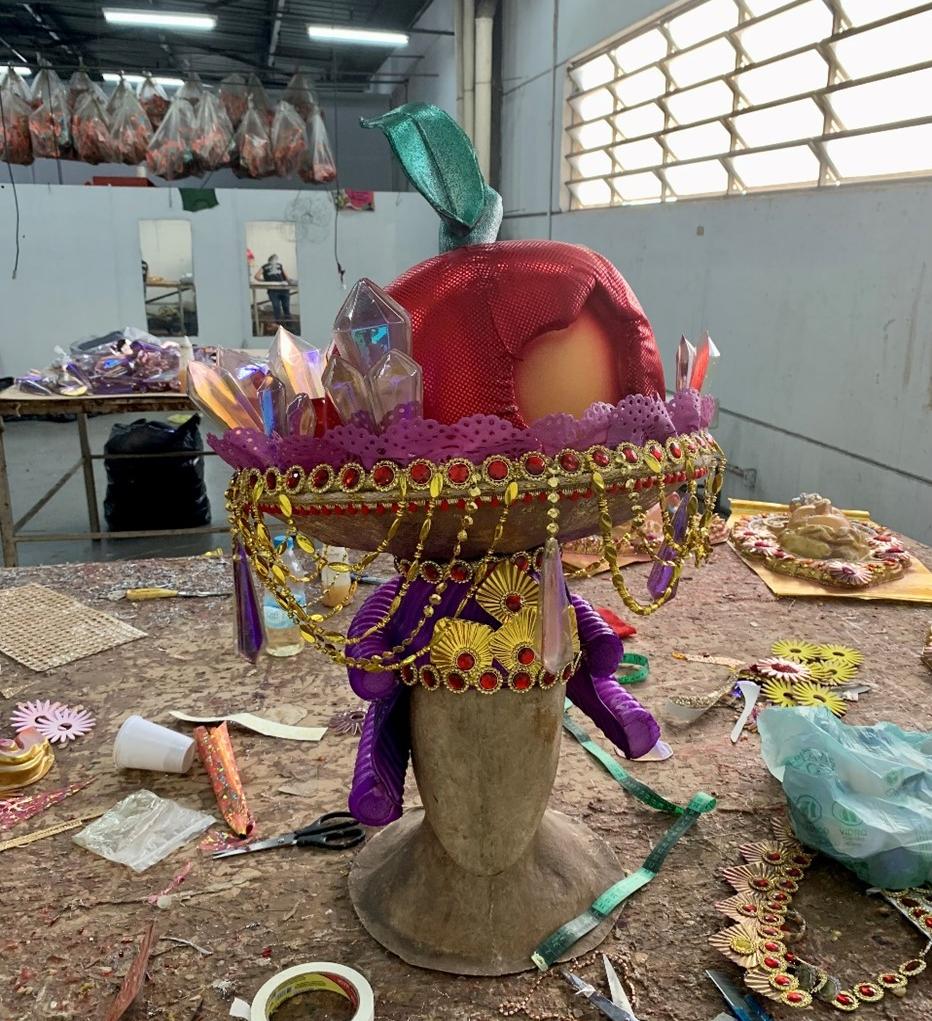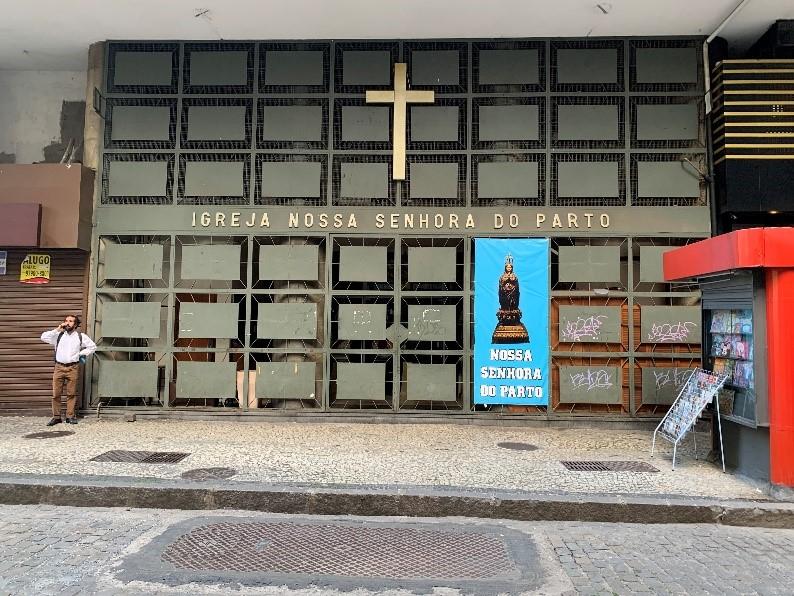The Life and Story of Rosa Maria: Brazil's First Black Author
archive


A carnival celebrant plays the part of Rosa María Egipciaca in Rio de Janeiro; February 21, 2023.
ALEX FERRO (VIRADOURO | RIOTUR)
The Life and Story of Rosa Maria: Brazil's First Black Author
Thirty years after the release of Rosa Maria Egipcíaca’s biography by Brazilian historian Luiz Mott in 1993, one of Rio’s strongest Carnival samba schools, Unidos do Viradouro, finally brought her name into Brazilian mainstream culture. Rosa Maria is Brazil’s first black author (her first manuscript is from 1752), having written a book and letters of prophecy. The book, however, was destroyed by Rosa Maria to avoid being used as proof against her in her Holy Inquisition Trial. Her story is global in both space and time. In her journey, Rosa traversed three different continents -- Africa, South America and Europe -- interconnected by the colonial ties of transatlantic slavery and Catholicism, and though she lived in the eighteenth century, her ‘afterlife’ extends until today, as I will describe below, through the context of Brazil’s Carnival.
What Is Carnival
Carnival, or Carnaval in Portuguese, is an annual festival which starts on the Friday before Ash Wednesday. At the heart of the festival is a spectacular three-day competition between samba schools – which are not actually “schools” but enormous dance and music organizations, each identified with and supported by the residents of a city community, usually an “urban peripheral” community with strong Afro-Brazilian or Northeastern social profile. Each “school,” each year, designs, engineers, and produces a series of giant floats and thousands of costumes which conform to a theme that is selected each year, and then send between 2000 and 3500 participants to dance and march to the beat of a newly composed samba whose lyrics and music give life to the selected theme which often pays tribute to heroes of subaltern Brazilian history.
Sadly, almost all of Rosa’s writings were destroyed in an effort to prevent them being used against her during her Holy Inquisition trial (1763-1765) in Lisbon for sorcery and heresy. At the same time, it was due to her extraordinary charismatic leadership amongst Catholic white men in Rio de Janeiro that she was given “the privilege” of a legal trial in the colonial metropole, not a formality granted to ordinary people, especially enslaved Africans. Despite the lack of material sources to preserve her voice, Rosa’s afterlife ironically comes through the documents and testimonies of her legal process, which were unexpectedly found at the Torre do Tombo archives in Lisbon, Portugal, by Luiz Mott who found the files of her trial accidently while researching in the Portuguese archives in the 1990s.
Rosa’s life story is one of mysticism, magic, and twists-and-turns. As can be seen in Luiz Mott’s book, her life resonates closely with Carnival’s ambivalences, combining poverty and luxury, oppression and catharsis, the sacred and the profane, the local and the global. In the fabulist parade of the Viradouro samba school, we see Rosa as an enslaved woman in pursuit of her freedom, initially through the means of sex work, and afterwards through religion. In a dramatized grand finale she becomes a Saint, “beatified” by the people of Brazil in a samba school parade.
As Brazilians often remark, Carnival is Brazil’s version of Hollywood. To be honored by being celebrated in the annual theme selected by one the samba schools in Rio’s Premier League (the top tier of competitive samba schools) means you have been celebrated in mainstream pop culture and become larger than life. Other Black Brazilian historical icons are frequently remembered in samba school parades, for instance, Chica da Silva, Madame Satã or Zumbi dos Palmares, but this was Rosa’s début at Marquês de Sapucaí, the avenue located in downtown Rio where twelve samba schools parade for a 60 thousand-member audience and for the jury that judges all schools and proclaims the champion of Carnival.

Rosa Maria in the In the parade’s last float, crowned a Saint, with her rosy mantle protecting other Black women.
Although Rosa lived two centuries before the advent of the modern Carnival competitions and the urban samba-school system, Rosa’s biography resembles the syncretism and ambiguity of samba schools in Brazil, a globalized mixture of sacredness and profanity, of European colonizers’ Catholicism and Candomblé. Candomblé is a polytheistic African religion that travelled across the Atlantic with many enslaved Africans. Despite centuries of institutional religious racism, Candomblé survived and is extremely popular in cities such as Rio and Salvador. The carnival’s ambiguity is also reflected in its financing: a mixture of governmental sponsorship from Rio’s municipality, big private companies and informal marchands, known as bicheiros who often launder their illicit gambling money through those samba schools. Every year millions of dollars are spent to make the show happen.
Though historically linked to Catholic tradition, with festivities ending the day before the start of Lent, Carnival today has become a celebration of Black cultural influence through the 20th century, also Rio’s strongest cultural commodity. Happiness, joy and freedom, expressed through music, dance, and costumes of nobility (e.g., kings and queens) mark this popular outdoor opera and give it a subtle political undertone, surreal satire or dreamlike interpretations, conducted by each samba school’s orchestra of 250 drummers. Most of its protagonists are structurally oppressed in different ways throughout the rest of the calendar year: mainly Black and/or Queer women; poor anonymous inhabitants of favelas who can be themselves in a sixty-minute parade.
Each samba school comes from a different favela, although a few of them have their origins in neighbourhoods, such as the oldest one, Portela, whose theme this year was its own centennial jubilee. Viradouro, for instance, has its origins in Viradouro Hill, a favela in the neighbouring municipality of Niterói. Nowadays ferries to Niterói depart from those exact same docks where Rosa first disembarked in Rio de Janeiro Brazil to be sold as a slave. She was originally from the Courana nation (near current Lagos, Nigeria), and was trafficked at the age of six, arriving in Rio’s port, then called Praia do Peixe (currently 15th November Square).
Rosa lived in Rio until the age of 14, when she was sold by her first proprietor and taken to Minas Gerais in 1733. A gold fever was spreading at the time, resulting in a growing enslaved labor force, as represented in Viradouro’s costumes. Sex work was also a widespread trade in the so-called “golden cycle” and allowed women (and some men) to access their freedoms through manumission. For instance, until 1749 people of African origins in Minas Gerais who secured manumission represented 1.4% of the state’s population. This proportion rose to nearly 42% in 1786 (Russel Wood 1982). The gender ratio of enslaved people was highly disproportional, with a vast predominance of enslaved men. For instance, Rosa’s proprietor Ana Garcês married Captain Durão, who had 77 male “slaves” and just one single woman. In spite of that, the manumission ratio was the opposite: for every freed man there were two manumitted women (Mott 1993), highlighting the importance of sex work as a women’s strategy. The low “supply” of women (especially white women) made sex a valuable commodity.
Rosa was a sex worker for fifteen years and, as represented in the samba school’s costumes, she was able to purchase goods such as jewellery, ornaments, and fabrics, though she never invested in her manumission. Luis Mott speculates that her patrimony probably amounted to much less than the 190 octaves of gold that Maria da Costa, a sex worker contemporary of Rosa, paid for her own manumission. In the visual representation of Rosa’s meretricious life, her costumes are loaded with gemstones, golden ornaments, and a bitten apple, alluding to biblical luxurious sins.

Headpiece of a costume representing Rosa’s luxurious life as a sex worker.
In a visit to Viradouro’s manufacturing warehouse thirty days before Carnival, the only float allowed to be photographed was the one representing the brothel where Rosa worked as a prostitute, with details that also resemble the gold and gemstones of 18th century colonial baroque in Minas Gerais state. It is not known why Rosa failed to secure her freedom. Whatever the reason, Rosa ultimately pursued her freedom through spiritual means. She claims she heard a voice whispering that she should sell all her goods and donate all earnings from it to the poor. This event marks the end of Rosa’s life as a sex worker, and the beginning of her religious path.
A New Journey
By 1751 when Rosa managed to move back to Rio de Janeiro, she had developed close ties with a priest and exorcist known as Xota-Diabos -- which literally translates to ‘kicks out demons’ -- who was a great enthusiast and propagandist of hers, even collecting alms to buy Rosa from her proprietor, Madam Ana Garcês, and later “giving” her manumission, due to her alleged supernatural abilities. After being “granted” her manumission, Rosa persuaded the priest to accompany her to Rio de Janeiro to “save her soul,” as well as to escape from local accusations of sorcery, witchcraft and heresy.
During her return to Rio in 1751, Rosa changed her name, becoming “Rosa Maria Egyptiac of Vera Cruz.” Again, time and space are reconfigured as Rosa resurrects a sixth century ascetic, Mary of Egypt or St. Mary of Egypt, or St. Mary Egyptiac, who retired to the desert in Palestine after a life of prostitution. (In Brazil, activists often prefer to rehabilitate and utilize the term “prostitution” rather than “sex worker” since they argue that the latter term embraces a respectability politics and re-centers the hyper-masculinized figure of a certain notion of “the worker”). St Mary is venerated as patroness of penitent women, especially in the Coptic Church, but also in the Catholic, Orthodox and Anglican Churches. Rosa appropriates the Egyptiac of the Saint’s name to claim her own holiness, adding Vera Cruz, the first name given by Portuguese navigators to the lands that would later be named Brazil. Her new pseudonym and alter-ego made Rosa harder to find, and simultaneously reaffirmed her saint-like identity amongst Catholic white men in this new urban setting, where she earned the nickname “Flower of Rio de Janeiro” given by friars.
Rosa’s biography is also extraordinary because she managed to persuade influential Catholic figures in Rio to collect a significant amount of alms -equivalent to 200 “slaves”- and build a retreat for sex workers who “regret their sins in the name of God”. That retreat, the Recollection Nossa Senhora do Parto, stood not far from where samba schools parade today. In it, Rosa housed 10 Black and Brown and 12 white women and hoped to one turn it into the main royal convent of the Portuguese Empire. That dream was not realized, and the building no longer exists. However, a church does, in a 1970s commercial building in the town center:

Rosa’s retreat no longer exists, however church Nossa Senhora do Parto survived in a different building.
In reality, Rosa’s life story ended tragically, locked up in Portugal’s Inquisition jail, but Viradouro’s Carnaval parade reinterpreted reality and revived her destiny through a fictionalized artistic dramatization. Brazil’s first Black writer was thus given a happy ending and a “profane” carnivalesque canonization as the “Saint of the people”, as they call her in the samba lyrics.
1. All photos taken by author except for banner image
Mott, Luiz. 1993. Rosa Egipcíaca: uma santa africana no Brasil. Rio de Janeiro: Bertrand Editors.
Mott, Luiz. 2017. “Egipcíaca, Rosa”. Oxford African American Studies Center. May 31, 2017.
Russel-Wood, A. J. R. 1982. The Black Man in Slavery and Freedom in Colonial Brazil. London: Palgrave Macmillan.



